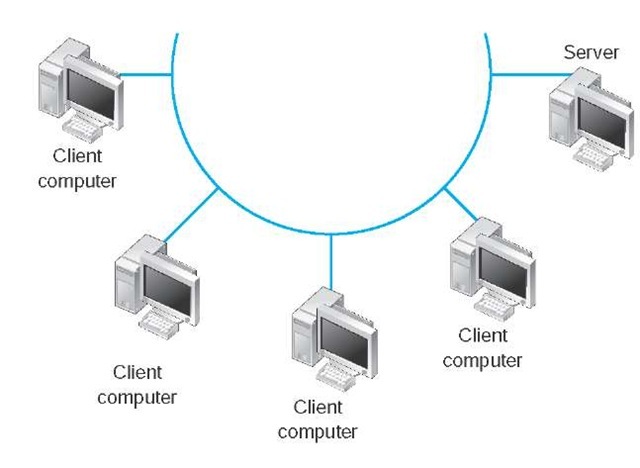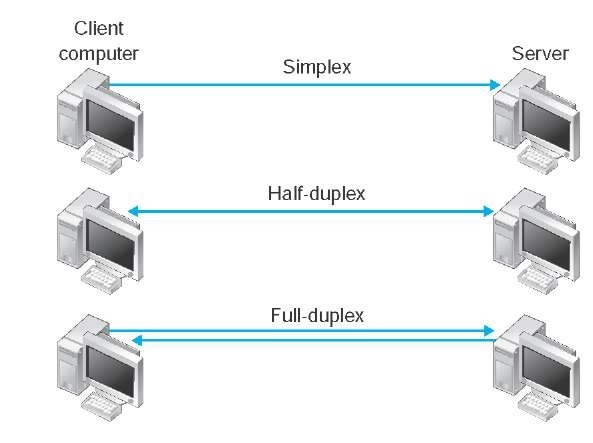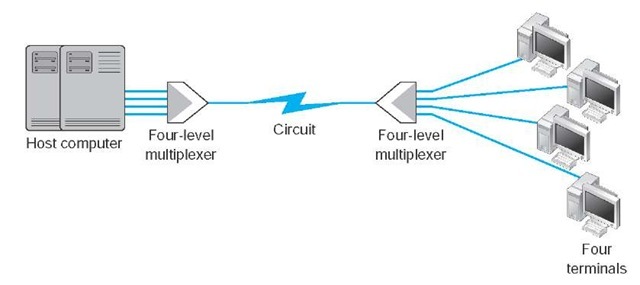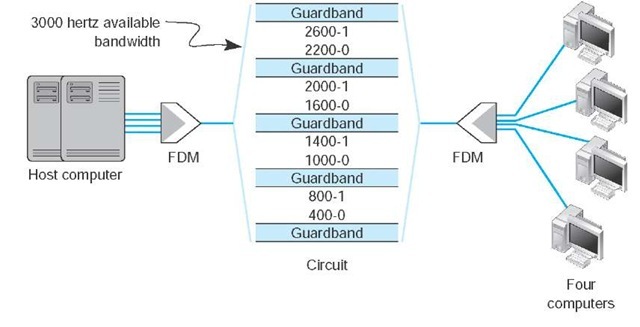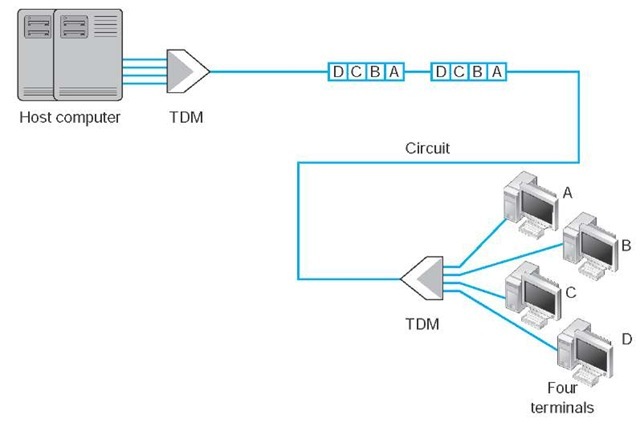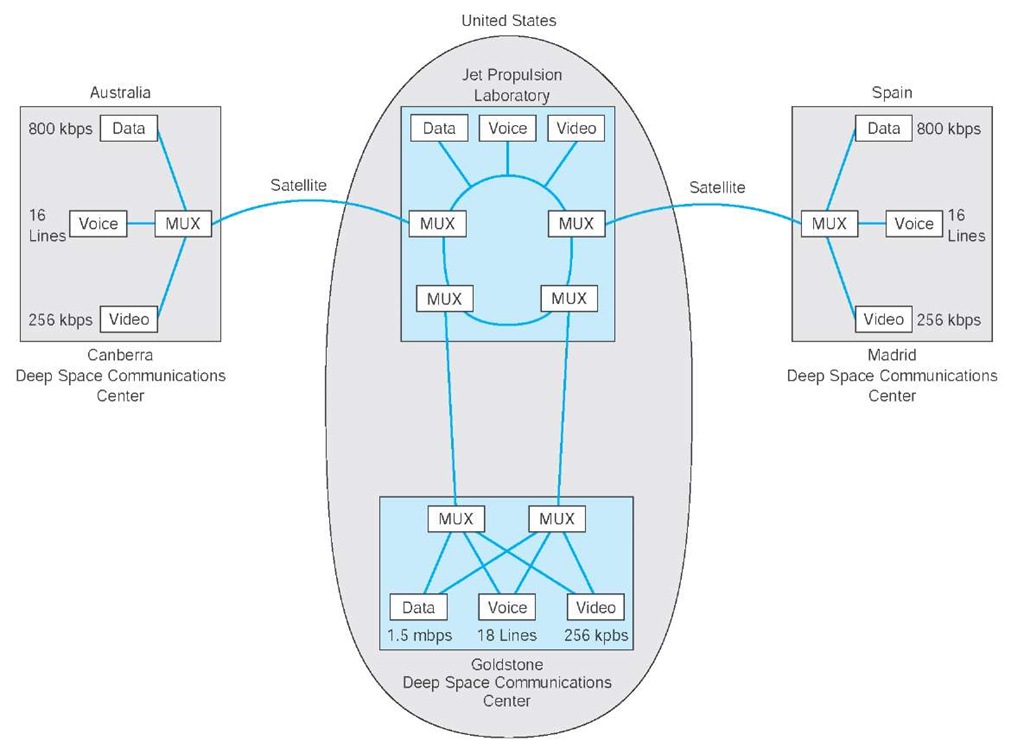Circuit Configuration
Circuit configuration is the basic physical layout of the circuit. There are two fundamental circuit configurations: point-to-point and multipoint. In practice, most complex computer networks have many circuits, some of which are point-to-point and some of which are multipoint.
Figure 3.1 illustrates a point-to-point circuit, which is so named because it goes from one point to another (e.g., one computer to another computer). These circuits sometimes are called dedicated circuits because they are dedicated to the use of these two computers. This type of configuration is used when the computers generate enough data to fill the capacity of the communication circuit. When an organization builds a network using point-to-point circuits, each computer has its own circuit running from itself to the other computers. This can get very expensive, particularly if there is some distance between the computers.
Figure 3.1 Point-to-point circuit
Figure 3.2 shows a multipoint circuit (also called a shared circuit). In this configuration, many computers are connected on the same circuit. This means that each must share the circuit with the others. The disadvantage is that only one computer can use the circuit at a time. When one computer is sending or receiving data, all others must wait. The advantage of multipoint circuits is that they reduce the amount of cable required and typically use the available communication circuit more efficiently. Imagine the number of circuits that would be required if the network in Figure 3.2 was designed with separate point-to-point circuits. For this reason, multipoint configurations are cheaper than point-to-point circuits. Thus, multipoint circuits typically are used when each computer does not need to continuously use the entire capacity of the circuit or when building point-to-point circuits is too expensive. Wireless circuits are almost always multipoint circuits because multiple computers use the same radio frequencies and must take turns transmitting.
Data Flow
Circuits can be designed to permit data to flow in one direction or in both directions. Actually, there are three ways to transmit: simplex, half-duplex, and full-duplex (Figure 3.3).
Simplex is one-way transmission, such as that with radios and TVs.
Half-duplex is two-way transmission, but you can transmit in only one direction at a time. A half-duplex communication link is similar to a walkie-talkie link; only one computer can transmit at a time.
Figure 3.2 Multipoint circuit
Figure 3.3 Simplex, half-duplex, and full-duplex transmissions
Computers use control signals to negotiate which will send and which will receive data. The amount of time half-duplex communication takes to switch between sending and receiving is called turnaround time (also called retrain time or reclocking time). The turnaround time for a specific circuit can be obtained from its technical specifications (often between 20 and 50 milliseconds). Europeans sometimes use the term simplex circuit to mean a half-duplex circuit.
With full-duplex transmission, you can transmit in both directions simultaneously, with no turnaround time.
How do you choose which data flow method to use? Obviously, one factor is the application. If data always need to flow only in one direction (e.g., from a remote sensor to a host computer), then simplex is probably the best choice. In most cases, however, data must flow in both directions.
The initial temptation is to presume that a full-duplex channel is best; however, each circuit has only so much capacity to carry data. Creating a full-duplex circuit means that the available capacity in the circuit is divided—half in one direction and half in the other. In some cases, it makes more sense to build a set of simplex circuits in the same way a set of one-way streets can speed traffic. In other cases, a half-duplex circuit may work best. For example, terminals connected to mainframes often transmit data to the host, wait for a reply, transmit more data, and so on, in a turn-taking process; usually, traffic does not need to flow in both directions simultaneously. Such a traffic pattern is ideally suited to half-duplex circuits.
Multiplexing
Multiplexing means to break one high-speed physical communication circuit into several lower-speed logical circuits so that many different devices can simultaneously use it but still "think" that they have their own separate circuits (the multiplexer is "transparent"). It is multiplexing (specifically, wavelength division multiplexing [WDM], discussed later in this section) that has enabled the almost unbelievable growth in network capacity discussed in last topic; without WDM, the Internet would have collapsed in the 1990s.
Multiplexing often is done in multiples of 4 (e.g., 8, 16). Figure 3.4 shows a four-level multiplexed circuit. Note that two multiplexers are needed for each circuit:
Figure 3.4 Multiplexed circuit
The primary benefit of multiplexing is to save money by reducing the amount of cable or the number of network circuits that must be installed. For example, if we did not use multiplexers in Figure 3.4, we would need to run four separate circuits from the clients to the server. If the clients were located close to the server, this would be inexpensive. However, if they were located several miles away, the extra costs could be substantial.
There are four types of multiplexing: frequency division multiplexing (FDM), time division multiplexing (TDM), statistical time division multiplexing (STDM), and WDM.
Frequency Division Multiplexing Frequency division multiplexing (FDM) can be described as dividing the circuit "horizontally" so that many signals can travel a single communication circuit simultaneously. The circuit is divided into a series of separate channels, each transmitting on a different frequency, much like series of different radio or TV stations. All signals exist in the media at the same time, but because they are on different frequencies, they do not interfere with each other.
Figure 3.5 illustrates the use of FDM to divide one circuit into four channels. Each channel is a separate logical circuit, and the devices connected to them are unaware that their circuit is multiplexed. In the same way that radio stations must be assigned separate frequencies to prevent interference, so must the signals in a FDM circuit. The guardbands in Figure 3.5 are the unused portions of the circuit that separate these frequencies from each other.
With FDM, the total capacity of the physical circuit is simply divided among the multiplexed circuits. For example, suppose we had a physical circuit with a data rate of 64 Kbps that we wanted to divide into four circuits. We would simply divide the 64 Kbps among the four circuits and assign each circuit 16 Kbps. However, because FDM needs guardbands, we also have to allocate some of the capacity to the guardbands, so we might actually end up with four circuits, each providing 15 Kbps, with the remaining 4 Kbps allocated to the guardbands. There is no requirement that all circuits be the same size, as you will see in a later section. FDM was commonly used in older telephone systems, which is why the bandwidth on older phone systems was only 3,000 Hz, not the 4,000 Hz actually available—1,000 Hz were used as guardbands, with the voice signals traveling between two guardbands on the outside of the channel.
Figure 3.5 Frequency division multiplex (FDM) circuit
Time Division Multiplexing Time division multiplexing (TDM) shares a communication circuit among two or more terminals by having them take turns, dividing the circuit vertically, so to speak. Figure 3.6 shows the same four terminals connected using TDM. In this case, one character is taken from each computer in turn, transmitted down the circuit, and delivered to the appropriate device at the far end (e.g., one character from computer A, then one from B, one from C, one from D, another from A, another from B, and so on). Time on the circuit is allocated even when data are not being transmitted, so that some capacity is wasted when terminals are idle. TDM generally is more efficient than FDM because it does not need guardbands. Guardbands use "space" on the circuit that otherwise could be used to transmit data. Therefore, if one divides a 64-Kbps circuit into four circuits, the result would be four 16-Kbps circuits.
Statistical Time Division Multiplexing Statistical time division multiplexing (STDM) is the exception to the rule that the capacity of the multiplexed circuit must equal the sum of the circuits it combines.
Figure 3.6 Time division multiplex (TDM) circuit
STDM allows more terminals or computers to be connected to a circuit than does FDM or TDM. If you have four computers connected to a multiplexer and each can transmit at 64 Kbps, then you should have a circuit capable of transmitting 256 Kbps (4 x 64 Kbps). However, not all computers will be transmitting continuously at their maximum transmission speed. Users typically pause to read their screens or spend time typing at lower speeds. Therefore, you do not need to provide a speed of 256 Kbps on this multiplexed circuit. If you assume that only two computers will ever transmit at the same time, 128 Kbps would be enough. STDM is called statistical because selection of transmission speed for the multiplexed circuit is based on a statistical analysis of the usage requirements of the circuits to be multiplexed.
The key benefit of STDM is that it provides more efficient use of the circuit and saves money. You can buy a lower-speed, less-expensive circuit than you could using FDM or TDM. STDM introduces two additional complexities. First, STDM can cause time delays. If all devices start transmitting or receiving at the same time (or just more than at the statistical assumptions), the multiplexed circuit cannot transmit all the data it receives because it does not have sufficient capacity. Therefore, STDM must have internal memory to store the incoming data that it cannot immediately transmit. When traffic is particularly heavy, you may have a 1- to 30-second delay. The second problem is that because the logical circuits are not permanently assigned to specific devices as they are in FDM and TDM, the data from one device are interspersed with data from other devices. The first message might be from the third computer, the second from the first computer, and so on. Therefore, we need to add some address information to each packet to make sure we can identify the logical circuit to which it belongs. This is not a major problem, but it does increase the complexity of the multiplexer and also slightly decreases efficiency, because now we must "waste" some of the circuit’s capacity in transmitting the extra address we have added to each packet.
Wavelength Division Multiplexing Wavelength division multiplexing (WDM) is a version of FDM used in fiber-optic cables. When fiber-optic cables were first developed, the devices attached to them were designed to use only one color of light generated by a laser or LED. With one commonly used type of fiber cable, the data rate is 622 Mbps (622 million bits per second). At first, the 622-Mbps data rate seemed wonderful. Then the amount of data transferred over the Internet began doubling at fairly regular intervals, and several companies began investigating how we could increase the amount of data sent over existing fiber-optic cables.
The answer, in hindsight, was obvious. Light has different frequencies (i.e., colors), so rather than building devices to transmit using only one color, why not send multiple signals, each in a different frequency, through the same fiber cable? By simply attaching different devices that could transmit in the full spectrum of light rather than just one frequency, the capacity of the existing fiber-optic cables could be dramatically increased, with no change to the physical cables themselves.
WDM works by using lasers to transmit different frequencies of light (i.e., colors) through the same fiber-optic cable. As with FDM, each logical circuit is assigned a different frequency, and the devices attached to the circuit don’t "know" they are multiplexed over the same physical circuit.
NASA’s Ground Communications Network
MANAGEMENT FOCUS
NASA’s communications network is extensive because its operations are spread out around the world and into space. The main Deep Space Network is controlled out of the Jet Propulsion Laboratory (JPL) in California. JPL is connected to the three main Deep Space Communications Centers (DSCCs) that communicate with NASA spacecraft. The three DSCCs are spread out equidistantly around the world so that one will always be able to communicate with spacecraft no matter where they are in relation to the earth: Canberra, Australia; Madrid, Spain; and Goldstone, California.
Figure 3.7 shows the JPL network. Each DSCC has four large-dish antennas ranging in size from 85 to 230 feet (26 to 70 meters) that communicate with the spacecraft. These send and receive operational data such as telemetry, commands, tracking, and radio signals. Each DSCC also sends and receives administrative data such as e-mail, reports, and Web pages, as well as telephone calls and video.
The three DSCCs and JPL use Ethernet local area networks (LANs) that are connected to multiplexers that integrate the data, voice, and video signals fortransmission. Satellite circuits are used between Canberra and JPL and Madrid and JPL. Fiber-optic circuits are used between JPL and Goldstone.
Dense WDM (DWDM) is a variant of WDM that further increases the capacity of WDM by adding TDM to WDM. Today, DWDM permits up to 40 simultaneous circuits, each transmitting up to 10 Gbps, giving a total network capacity in one fiber-optic cable of 400 Gbps (i.e., 400 billion bits per second). Remember, this is the same physical cable that until recently produced only 622 Mbps; all we’ve changed are the devices connected to it.
DWDM is a relatively new technique, so it will continue to improve over the next few years. As we write this, DWDM systems have been announced that provide 128 circuits, each at 10 Gbps (1.28 terabits per second [1.28 Tbps]) in one fiber cable. Experts predict that DWDM transmission speeds should reach 25 Tbps (i.e., 25 trillion bits per second) within a few years (and possibly 1 petabit [Pbps], or 1 million billion bits per second)—all on that same single fiber-optic cable that today typically provides 622 Mbps. Once we reach these speeds, the most time-consuming part of the process is converting from the light used in the fiber cables into the electricity used in the computer devices used to route the messages through the Internet. Therefore, many companies are now developing computer devices that run on light, not electricity.
Inverse Multiplexing Multiplexing uses one high-speed circuit to transmit a set of several low-speed circuits. It can also be used to do the opposite. Inverse multiplexing (IMUX) combines several low-speed circuits to make them appear as one high-speed circuit to the user (Figure 3.8).
One of the most common uses of IMUX is to provide T1 circuits for WANs. T1 circuits provide data transmission rates of 1.544 Mbps by combining 24 slower-speed circuits (64 Kbps). As far as the users are concerned, they have access to one highspeed circuit, even though their data actually travel across a set of slower circuits.
Until recently, there were no standards for IMUX. If you wanted to use IMUX, you had to ensure that you bought IMUX circuits from the same vendor so both clients or hosts could communicate.
Figure 3.7 NASA’s Deep Space Communications Centers ground communications network. MUX = multiplexer
Several vendors have recently adopted the BONDING standard (Bandwidth on Demand Interoperability Networking Group). Any IMUX circuit that conforms to the BONDING standard can communicate with any other IMUX circuit that conforms to the same standard. BONDING splits outgoing messages from one client or host across several low-speed telephone lines and combines incoming messages from several telephone lines into one circuit so that the client or host "thinks" it has a faster circuit.
The most common use for BONDING is for room-to-room videoconferencing. In this case, organizations usually have the telephone company install six telephone lines into their videoconferencing room that are connected to the IMUX. (The telephone lines are usually 64-Kbps ISDN telephone lines.) When an organization wants to communicate with another videoconferencing room that has a similar six-telephone-line IMUX configuration, the first IMUX circuit uses one telephone line to call the other IMUX circuit on one of its telephone lines. The two IMUX circuits then exchange telephone numbers and call each other on the other five lines until all six lines are connected. Once the connection has been established, the IMUX circuits transmit data over the six lines simultaneously, thus giving a total data rate of 6 x 64 Kbps = 384 Kbps.
Figure 3.8 Inverse multiplexer
Get More Bandwidth for Less
MANAGEMENT FOCUS
Upstart network provider Yipes is among the first to offer metropolitan area network services based on wavelength division multiplexing (WDM). It offers circuits that range from 1 Mbps up to 1 Gbps in 1-Mbps increments and costs anywhere between 10 percent and 80 percent of the cost of traditional services. The challenge Yipes faces is to expand its WDM services beyond the MAN.
How DSL Transmits Data
The reason for the limited capacity on voice telephone circuits lies with the telephone and the switching equipment at the telephone company offices. The actual twisted-pair wire in the local loop is capable of providing much higher data transmission rates. Digital subscriber line (DSL) is one approach to changing the way data are transmitted in the local loop to provide higher-speed data transfer. DSL is a family of techniques that combines analog transmission and FDM to provide a set of voice and data circuits. There are many different types of DSL, so many in fact that DSL is sometimes called xDSL, where the x is intended to represent one of the many possible flavors.
With DSL, a DSL modem (called customer premises equipment [CPE]) is installed in the customer’s home or office and another DSL modem is installed at the telephone company switch closest to the customer’s home or office. The modem is first an FDM device that splits the physical circuit into three logical circuits: a standard voice circuit used for telephone calls, an upstream data circuit from the customer to the telephone switch, and a downstream data circuit from the switch to the customer. TDM is then used within the two data channels to provide a set of one or more individual channels that can be used to carry different data. A combination of amplitude and phase modulation is used in the data circuits to provide the desired data rate (the exact combination depends on which flavor of DSL is used).2 One version of DSL called G.Lite ASDL provides one voice circuit, a 1.5-Mbps downstream circuit, and a 384-Kbps upstream channel.

